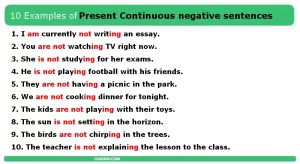The negative form of the irregular verb BE in English is used to indicate the absence or non-existence of a person, thing, or situation. In this blog post, we will go into depth on how to form negative sentences with the verb BE in different tenses, as well as provide some examples.
The use of the verb BE in the negative form in different tenses
To form a negative sentence with the verb BE in the present simple tense, we add the word “not” after the verb. For example, instead of saying “He is happy”, we say “He is not happy.” This rule applies to all subjects, singular or plural.
In the past simple tense, we add the word “not” after the auxiliary verb WAS or WERE. For example, instead of saying “They were happy”, we say “They were not happy.” Again, this rule applies to all subjects.
In the present continuous tense, we add the word “not” after the auxiliary verb BE. For example, instead of saying “She is studying”, we say “She is not studying.”
In the past continuous tense, we add the word “not” after the past tense of the auxiliary verb BE. For example, instead of saying “They were playing soccer”, we say “They were not playing soccer.”
In the present perfect tense, we add the word “not” after the auxiliary verb HAVE. For example, instead of saying “She has finished her work”, we say “She has not finished her work.”
In the past perfect tense, we add the word “not” after the auxiliary verb HAD. For example, instead of saying “They had already eaten”, we say “They had not already eaten.”
It’s important to note that in the negative form of the verb BE, the word “not” is often contracted with the auxiliary verb. For example, “He is not happy” can be contracted to “He isn’t happy.” This is common in casual conversations.
Investigate also verb forms of BE (V1, V2, V3, V4, V5) and BE in the past and participle form.
More examples of Negative sentences with the verb BE
Look also at:
In conclusion, the negative form of the verb BE is an essential aspect of English grammar that allows us to indicate the absence or non-existence of a person, thing, or situation. By following the rules outlined in this blog post, you can confidently form negative sentences with the verb BE in different tenses.

